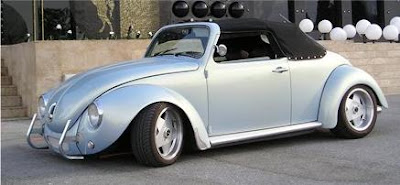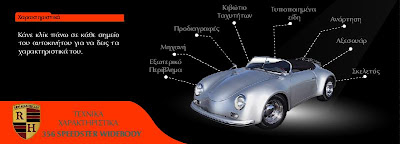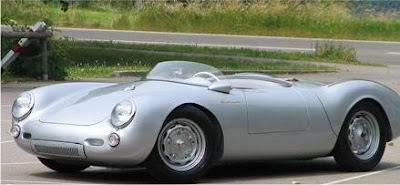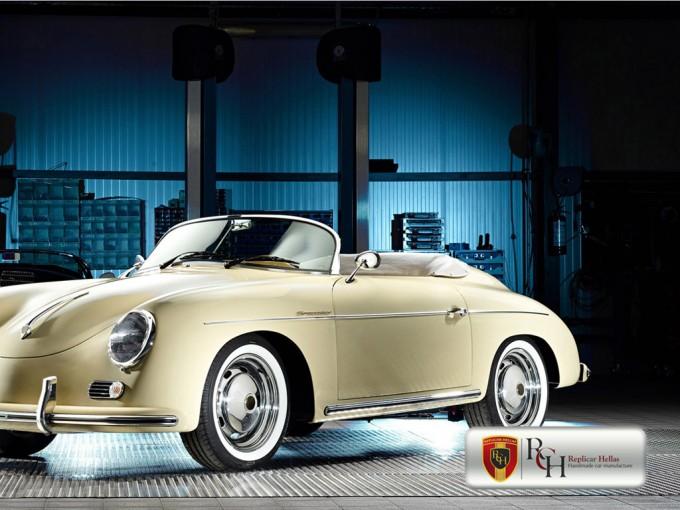Did you know that Porsche replicas are manufactured in Katerini?
And yet it's true and you won't believe the quality of the cars!
Replicar Hellas: The Greek craft of manufacturing REPLICA cars from Katerini all over the world!!!
Who said that in Greece there are no possibilities for the construction of cars by people who have knowledge and love cars? Read this post carefully.”
A few words about the company: The company is active in the field of Replica and the construction of old models, car copies and their improvements. Replicar Hellas' experience stems from 25 years of continuous presence and involvement in the automotive industry as well as further specialization in fields such as body reconstructions and conversions or even mechanical improvements on Replicas. According to the company, the prices are characterized as reasonable and correspond to the quality and reliability of its work. The construction of the cars is done by the company itself, here in Greece, from the beginning to the final stage, without the use of ready-made kits coming from abroad. Which models does the Greek company manufacture:

1. Beetle or VW Beetle "Beetle" or otherwise Beetle, cochineal, scarab, are some of the names of the unique "people's car" of Volkswagen. The dream of a people's car began in 1931 by Ferdinand Porsche, who presented the first designs on this idea. The 3rd Reich and the Hitler regime will give the "green light" for such a construction that will be called "Volks Wagen" which means "people's car". Until 1945, when the production of the car was discontinued, 1,100 civilian cars were manufactured. The famous model, from 1949, when the Deluxe version was first presented, to 1975, was constantly evolving in both its exterior design and its mechanical parts. It is worth mentioning that the platform-chassis of the Beetle was the mother of… the first Porsche 356. On June 8, 1948, the first prototype vehicle with the Porsche logo and code 356-001 received type approval for production. “It all started when I started looking but couldn’t find the car of my dreams anywhere. So, I decided to build it myself,” said Ferry Porsche, referring to the 356, the first Porsche in history.
The air-cooled, four-cylinder boxer engines came from the VW Beetle, as did most of the mechanical parts. The first 356 models were equipped with a 35 hp engine. Thanks to the limited weight of 585 kg, they reached a top speed of 135 km/h.
In the 1950s, the 550 appeared, and by 1954 the name Porsche had become synonymous with motor racing. Notably, in the same year the company's racing cars, mainly in private hands, managed to achieve 214 victories in various types of races around the world.
The two above models began to become unpopular over time. Thus, from the early 1980s, various manufacturers turned to the solution of producing "replica" cars for these specific models.
For these conversions, most used the VW Beetle chassis as a basis because it was and remains simple in design and construction, but also because of the initial affinity of the two cars, while later there were also companies that manufactured and still manufacture 356 and 550 replicas on tubular chassis.

2. Porsche 356 Speedster
When the Porsche design team was working on a car for the Cisitalia Grand Prix, Ferdinand Porsche wondered how he could make something like the Italian car with VOLKSWAGEN parts, which were the only kind of parts he could find in Germany and Austria after the war. He managed to build a sports car. The chassis was made from a network of tubes. A VOLKSWAGEN engine was fitted at the rear, with its gearbox in front of the axle to give the car a better balance. It was a flat air-cooled 4-cylinder engine of 1131 cc, improved from 25 to 40 bhp.
The design program number 356 was declared in June 1947 and the first Type 356 chassis (356-001) was produced in March 1948.
Erwin Kommenda designed the bodywork that was in effect for 27 years.
The first prototype was sold in July 1948 to Von Senger, a Swiss dealer, for 7000 francs to help finance it. This prototype is in the Porsche Museum.
At the same time, the designers were working on a similar model, the type 356/2 (356-002). The engine and rear suspension were on a separate chassis, but they still used VOLKSWAGEN mechanical parts.
Von Senger and his partner Bernhard Blank ordered 50 cars along with supplies of spare metal parts and engines. The mechanical specifications varied, but the engine was around 1100 cc with a top speed of 141 km/h (88 mph). The 356/2 design became the "Porsche 356".
Porsche moved to Stuttgart in 1950.
The first car was produced in May 1950, the remaining 500 were produced in March 1951 and the next 1000 in September 1951. They had 1100 or 1300 CC engines.
Porsche sold the cars in various countries: Sweden, USA, France etc. They made various changes in 1951-52 such as a 1500 CC engine, one-piece windshield, ventilated disc brakes, and modernized the instruments - dashboard. They designed an open car for the American market with an aluminum body which sold well in America from April 1952.
Fewer cars were ordered with 1100 or 1300 CC engines, so the 1500 engine was offered in two horsepower versions.
Because of this larger engine, Porsche designed a new synchronized gearbox. Larger brakes were also installed.
In September 1955 Porsche began production of the 356 A. It had a new crankshaft so the capacity was increased to 1600 CC, the maximum capacity in the racing class.
The 356 had four different engines, plus the new 1500GS Carrera, named after the company's successes in the Carrera Panamericana race.
In 1954 the Speedster was introduced to America.
In 1965 the 356 type ran out of production life. The new Porsche was coming: the 911

3. Porsche 550 Spyder
In 1998, the Porsche Boxster debuted to great acclaim, drawing attention away from its predecessor, the 550 RS Spyder. The 550 had already established an immortal place in the global consciousness. American-born car importer Johnny Von Neuman played an integral role in the Spyder’s commercial success. He is credited with helping to popularize the “Spyder” by helping to guide James Dean into buying a Spyder for $ 25,000 German marks, which became known as the “Little Bastard.”
Replicar Hellas provides additional services related to the following topics:
1) Oldtimer Restoration
2) Manufacture of polyester molds
3) Manufacturing and repairing broken racing car parts
GRP – CFRP – ARAMID
4) Manufacture of genuine electrical harness for antique (oldtimer) and replica cars
5) Mechanical improvements, air-cooled and water-cooled engines in our cars
6) Manufacturing of speedster racing seats in sizes SL-XL and upholstery
The company also provides services related to:
a. Body shops
b. Car painting
c. Electrical installation
d. Wallpaper installation
e. Seat Upholstery
f. Installation and panel lining
g. Machine Shop and Application Services
More important information about sales prices and technical specifications of available models can be found here.
http://www.replicarhellas.com

